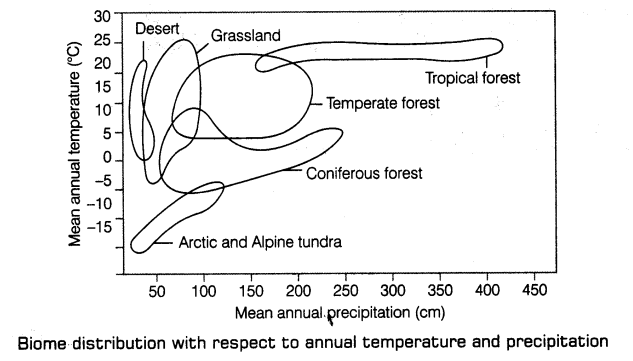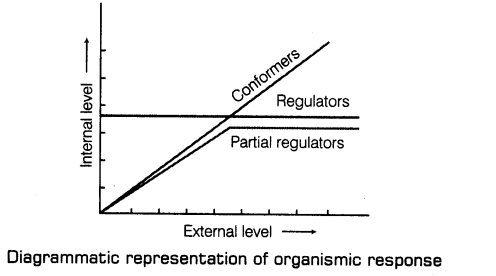Notes For All Chapters Biology Class 12 CBSE
Organisms and Its Environment:
1. Ecology is the branch of biology, which studies the interactions among organisms and their physical (abiotic) environment.
2. The subject ecology is basically concerned with four levels of biological organisation.
These are given below:
(i) Organism Living component of the environment at individual level and is basic unit of ecological hierarchy.
(ii) Population The sum total of all individuals of a species in a specific geographical area.
(iii) Communities Assemblage of all the populations of different species present in an area that interact among themselves.
(iv) Biome It is a large unit, which consists of a major vegetation type, associated fauna in a particular climatic zone. Tropical rainforest, deciduous forest, sea coast, deserts, etc., are the major biomes of India.
Note: Other important terms used in ecology are:
Ecosystem Represents, the organisms and their environment in a particular area.
Habitat It refers to a specific place or locality delimited by a combination of factors, physical features and barriers where a community dwells.
Niche The ecological niche of an organism represents the physical space occupied by it, the resources it utilises and its functional role in the ecological system.
Biosphere The surface of earth with all life forms, i.e. union of all ecosystems. It is a highly ordered system.
3. Environment Ecology at organism level deals with how different organisms are adapted to their environment in terms of their survival and reproduction.
(0 Different biomes are formed due to: .
(a) annual variations in the intensity and duration of temperature.
(b) annual variations in precipitation.
The major biomes of the world are desert, grassland, rainforest and tundra.
(ii) Regional and local variations within each biome lead to the formation of a wide variety of habitats.
(iii) Life on earth exists in favourable habitats as well as in extreme and harsh habitats like scorching Rajasthan desert, rain-soaked Meghalaya forests, deep ocean trenches, torrential streams, permafrost polar regions, high mountain tops, boiling thermal springs and stinking compost pits and even in our intestine.
(iv) The biotic components of a habitat are pathogens, parasites, predators and competitors of the organism with which they interact constantly.
(v) The key abiotic elements that lead to variations in habitats are:
(a) Temperature (b) Water
(c) Light (d) Soil.
4. Major abiotic factors are:
(i) Temperature is the major abiotic factor, which is most ecologically relevant.
(a) There is seasonal variation in average temperature of land.
(b) It decreases progressively from the equator to the poles and from plain areas to the mountains.
(c) The range of temperature varies from sub-zero levels in polar areas to >50°C at high altitude in tropical deserts during summer.
(d) The temperature affects the kinetics of body enzymes and thus, the basal metabolism and other physiological functions of the organism.
(e) Based on tolerance of temperature range, organisms can be divided as:
Euiythennal These can tolerate a wide range of temperature.
Stenothermal These can tolerate a narrow range of temperature.
(ii) Water is the next major important factor without which life cannot exist.
(a) The productivity and distribution of plants in an environment depends on amount of water available.
(b) For aquatic organisms, the quality (chemical composition and pH) of water is important.
(c) Salinity refers to salt concentration (measured in parts per thousand) of water. Salt concentration is less than 5 in land water, 30-35 in sea and more than 100 in some hyper saline lagoons.
(d) Based on tolerance of range of salinity, organisms can be grouped as:
Euryhaline Organisms, which can tolerate a narrow range of salinity.
Stenohaline Organisms, which can tolerate a narrow range of salinity.
(e) Many freshwater animals cannot live for long in seawater and vice versa because of the osmotic problems they would face.
(iii) Light is an essential factor for the process of photosynthesis performed by autotrophs.
(a) Oxygen is released during photosynthesis.
(b) Many small plants like herbs and shrubs can perform photosynthesis under very low light conditions because they are overshadowed by tall, canopied trees.
(c) Most of the plants also depend on sunlight to meet their photoperiodic requirement for flowering.
(d) Light is also important for many animals as they use the diurnal and seasonal variations in light intensity and difration (photoperiod) as cues for timing their foraging, migratory and reproductive activities.
(e) The UV component of solar radiation is harmful to many organisms. All the colour components of the visible spectrum are not available for marine plants living at different depths of the ocean.
(iv) Soil The nature and properties of soil vary from place to place. It depends on climate, weathering process and whether soil is transported or sedimentary and how its development occurred.
(a) The soil composition, grain size and aggregation determine the percolation and water holding capacity of the soils.
(b) The characteristics like pH, mineral composition and topography determine the vegetation of an area.
(c) This in turn dictates the type of animals supported.
5. Responses to abiotic factors determines how organisms can cope or manage with stressful conditions of the habitat.
(i) During the course of millions of years of their existence, many species would have evolved a relatively constant internal (within the body) environment that permits all biochemical reactions and physiological functions to proceed with maximal efficiency and thus, enhance the overall fitness of the species.
(ii) The organisms should try to maintain the constancy of its internal environment,
i. e. homeostasis, despite of varying external environmental conditions that tend to upset its homeostasis.
(iii) Human beings can maintain their homeostasis by using artificial means
(air conditioner in summer and heater in winter).
(iv) Ways by which other organisms can cope up with environmental changes are given below:
Regulate
(a) Some organisms maintain homeostasis by physiological and sometimes behavioural means.
(b) All birds and mammals and few lower vertebrates and invertebrates are capable of thermoregulation and osmoregulation.
(c) In mammals, during summer, sweating occurs profusely and the evaporation brings down temperature of the body.
(d) In mammals, during winter, shivering occurs which is a kind of exercise that produces heat and raises the body temperature.
(e) Plants, on the other hand, do not have such mechanisms to maintain their internal temperature.
Conform
(a) About 99% of animals and almost all plants cannot maintain a constant internal environment. Their body temperature changes with the ambient temperature.
(b) In aquatic organisms, the osmotic concentration of the body fluids change with that of the osmotic concentration of the ambient water. These animals and plants are called conformers.
(c) Thermoregulation is energetically expensive for many organisms. This is specially true for small animals like shrews and humming birds.
Heat loss or gain is a function of surface area. Since, smal^animals have a larger surface area relative to their volume, they tend to lose body heat very fast when it is cold outside; they have to expend much energy to generate body heat through metabolism. This is the reason that very small animals are rarely found in polar regions.
(d) It can be concluded that during the course of evolution, some species have evolved the ability to regulate but only over a limited range of environmental conditions, beyond which they simply conform.
Migrate
It is the temporary movement from a stressful habitat to a more hospitable area and
return, when the stressful period is over.
(a) Many animals, particularly birds, during winter undertake long-distance migrations to more hospitable areas.
(b) Every winter the famous Keolado National Park in Bharatpur (Rajasthan) hosts, thousands of migratory birds coming from Siberia and other extremely cold Northern regions every winter.
Suspend
(a) Under unfavourable conditions bacteria, fungi and lower plants slow down their metabolic rate and forms a thick-walled spore to overcome stressful conditions. These spores germinate under onset of suitable environment.
(b) In higher plants, seeds and some other reproductive structures serve as means to tide over periods of stress. They reduce their metabolic activity and undergo dormancy.
(c) Some animals, which fail to migrate might avoid the stress by escaping in time. For example, Bear undergoes hibernation during winter.
(d) Some snails and fish undergo aestivation to avoid summer related problems.
(e) During unfavourable conditions, many zooplanktons in lakes and ponds enter diapause (a stage of suspended development).
6. Adaptation is any attribute of an organism, i.e. morphological, physiological or behavioural, that enables the organism to survive and reproduce in its habitat. Many adaptations have evolved over a long evolutionary time and are genetically fixed.
Some examples of adaptations are:
(i) Adaptations in kangaroo rat
(a) The kangaroo rat in North American deserts is capable of meeting all its water requirements by internal oxidation of fat (water is a byproduct) in the absence of water.
(b) It can concentrate its urine, so that minimal volume of water is used to expel excretory products.
(ii) Adaptations in desert plants
(a) Many desert plants have a thick cuticle on their leaf surfaces and have their stomata arranged in deep pits to minimise water loss through transpiration.
(b) They have special photosynthetic pathway (CAM) that enables their stomata to remain closed during day time.
(c) Some desert plants like Opuntia, have no leaves. They are reduced to spines and photosynthesis occurs in flattened stems.
(iii) Adaptations in mammals
(a) Mammals from colder climates generally have shorter ears and limbs to minimise heat loss. This is called Allen’s rule.
(b) In polar seas, aquatic mammals like seals have a thick layer of fat (blubber) below their skin that acts as an insulator and reduces loss of body heat.
(iv) Adaptations at high altitudes in humans
(a) At high altitude places like Rohtang Pass near Manali (> 3500 m) and Mansarovar, in China occupied Tibet, people suffer from altitude sickness.
(b) Its symptoms are nausea, fatigue and heart palpitations.
(c) This is because at low atmospheric pressure of high altitudes, body does not get enough oxygen.
(d) The relief occurs gradually due to acclimatisation.
(e) The body cope up with this low oxygen stress by
• Increasing red blood cells production.
• Decreasing the binding affinity of haemoglobin.
• Increasing the breathing rate.
(v) Adaptations in desert lizards (Behavioural response)
(a) They absorb heat from the sun when their body temperature drops below the comfort zone.
(b) They move into shade when the ambient temperature starts increasing.
(c) Some species burrow into the soil and escape from the above ground heat.


Leave a Reply